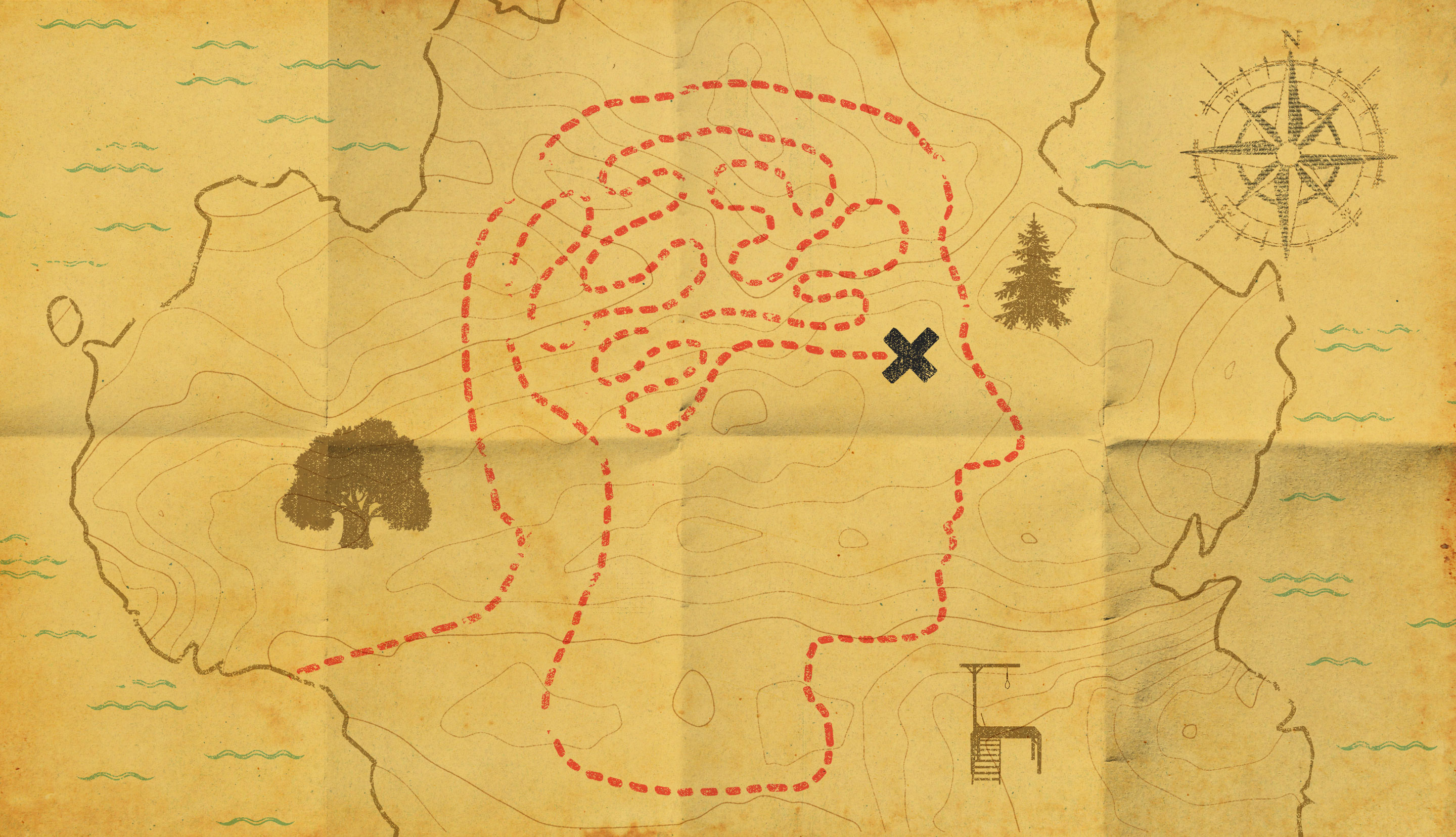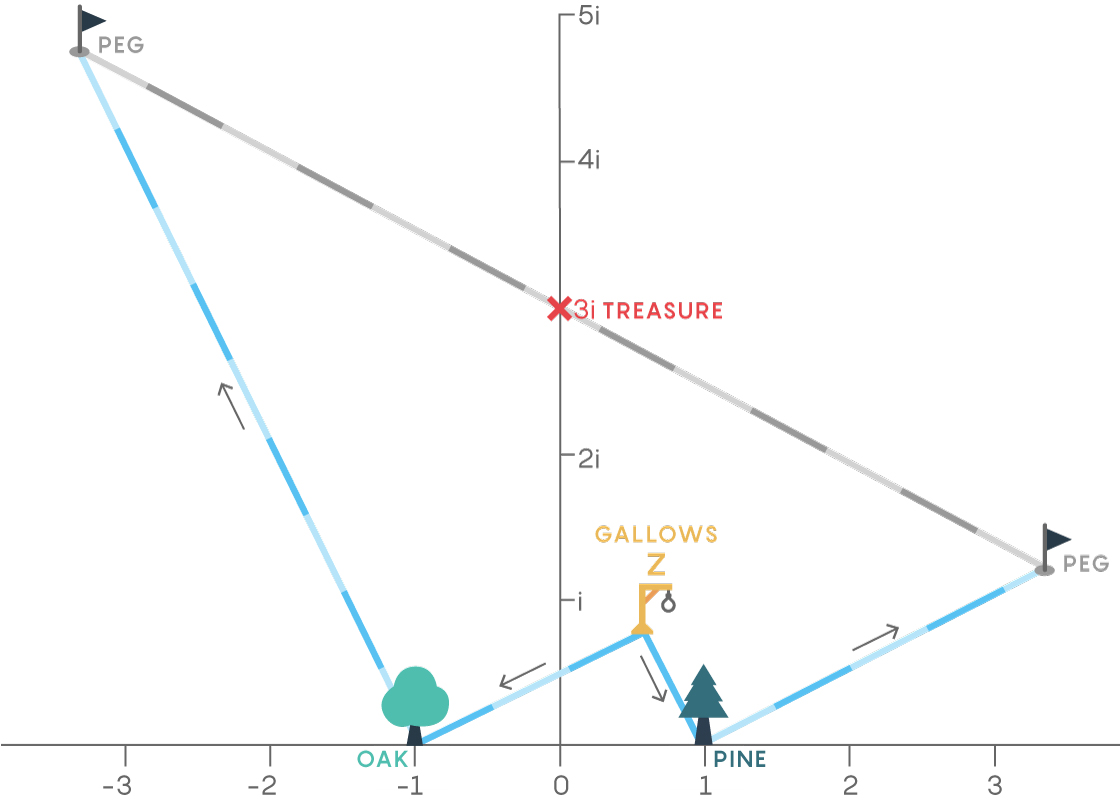Solution: ‘How to Find Simple Treasures in Complex Numbers’

Dan Page for Quanta Magazine
Introduction
Our February Insights puzzle sent readers on a treasure hunt based on complex numbers. First we provided a bit of a primer, demonstrating that complex numbers (expressions of the form a + bi, where the real numbers a and b join the imaginary unit i, which represents the square root of –1) arise as naturally in mathematics as any other kind of number. They do not deserve the epithet “imaginary.” Just as negative numbers are unnatural in the domain of countable objects, but become perfectly natural as debts in the realm of accounting and as distances to the left of the origin on the number line, so too complex numbers arise completely naturally when we move from the one-dimensional number line to the two-dimensional plane.
Last month, we showed how all points on a two-dimensional plane could be assigned unique complex numbers whose real and imaginary parts indicated their horizontal and vertical distances from the origin, respectively. Like the more familiar real numbers, these numbers, too, can be added or multiplied to yield another complex number. These algebraic operations correspond exactly to specific geometric manipulations that take you to the point represented by the result. Addition is now vector addition, and multiplication represents turning around the origin, with a clockwise right angle turn the result of multiplying by i, and a counterclockwise turn the result of multiplying by –i. The midpoint of two points on the complex plane is simply their mean.
With these complex number basics in mind, let’s solve our February puzzle and locate the hidden treasure.
Finding Treasure One
Our first treasure hunt was a variant of one originally described by the famed nuclear physicist George Gamow in his book One, Two, Three … Infinity. The treasure hunt takes place on an island that has two trees (an oak and a pine) and an ancient gallows. Here’s the key passage that shows how to find the treasure based on these three points:
“Start thou from the gallows and walk to the oak counting thy steps. At the oak thou must turn right by a right angle and take exactly three times as many steps as thou just took to reach the tree. Put here a spike into the ground. Now must thou return to the gallows and walk to the pine counting thy steps. At the pine thou must turn left by a right angle and again take exactly three times as many steps as thou took to reach the tree. Put thou another spike into the ground. Dig halfway between the spikes; the treasure is there.”
Unfortunately, the gallows has disappeared, leaving no trace. Can we still find the treasure?
Sure! All we have to do is apply the operations described above on the complex plane. Let us lay down the real axis so that the oak is at –1 and the pine is at +1. (Note that we are free to choose any coordinates for these two points whatsoever, because we can always map these coordinates to any arbitrary system: As mathematicians say, this choice can be made “without loss of generality.”)
Following convention, let us assign the letter z to the hypothetical point where the gallows was, and see where that takes us. (In his account, Gamow humorously used the Greek letter gamma (Γ) for this purpose, because “it looks like a gallows.” Well, you can think of z as a modern gallows, designed with a more stable center of gravity.) Since turning through a right angle is defined around the origin, let us pretend for a moment that the oak is the origin. Relative to the oak, the gallows is at z + 1. We need to multiply by i and then by 3 to find the position of the first spike, which is therefore at 3i(z + 1) = 3iz + 3i, relative to the oak. Relative to the true origin, this point will be 3iz + 3i – 1, since the oak is displaced by –1 from the true origin. Similarly, the second spike is at 3(–i)(z – 1) = 3i – 3iz relative to the pine, which becomes 3i – 3iz + 1 in true coordinates. The treasure is at the midpoint of the spikes, which is at (3iz + 3i – 1 + 3i – 3iz + 1)/2 which is just 3i — the z terms and the 1s cancel out. So the position of the gallows is irrelevant to the position of the treasure. Sneaky pirate! In the words of the puzzle solver Douglas Felix, “in order to find the pirate treasure, you place yourself halfway between the oak and pine, with the oak d steps ahead of you and the pine d steps behind, you turn right, walk 3d steps, and dig!”

Lucy Reading-Ikkanda/Quanta Magazine
All the treasure hunter had to do, instead of digging randomly and failing, was imagine a virtual gallows at any random point. As was the case with our very first Insights puzzle, “Can Information Rise From Randomness,” real information can be “magically” obtained by the treasure hunter from a random guess.
While our story of lost treasure was tragic for the protagonist, congratulations to the readers who did find this treasure. MZH went above and beyond, revealing the location in verse. Clever! Also ingenious was Ahmad Khalifa, who used the smart-aleck reasoning that the puzzle could have been asked only if the position of the gallows was irrelevant, so we can place the gallows wherever we like. To make it simple, we can place it at the origin, with the oak at (–1,0) and the pine at (+1,0). Now we can easily visualize that the treasure will be at (0,3).
Finding Treasure Two
For problem two, the clue to the treasure came in the form of this cryptic poem:
An eye for an eye and a tooth for a tooth
Recall thee the pirate creed. Forsooth!
At the lonely oak we rounded traitors, aye!
Then took them to the pine, minus eye.
Dead men’s chests swelled the treasure so big!
Ponder ye the creed: eye to the eye! Now go dig.
The only person who managed to decipher this poem in the way I intended was Manuel Fortin. Here are the key lines (translated):
At the lonely oak we rounded traitors, aye! (The oak is at i.)
Then took them to the pine, minus eye. (The pine is at –i.)
Ponder ye the creed: eye to the eye! Now go dig. (The treasure is at ii.)
So how do we find ii? For this we require Euler’s immortal formula (also called Euler’s identity), eiπ = –1, that relates three famous mathematical constants coming from totally different mathematical universes: e, π and i. For now, let’s ignore what this formula means and just use it to find our treasure.
Starting from Euler’s identity and taking the square root of both sides, we get, eiπ/2 = i. Raising both sides to i, we get e–π/2 = ii. You can punch e–π/2 into a scientific calculator to find the answer, which is about 0.208. Strange as it may seem, ii is a real number whose value is about 1/5!
The rest is easy. In the words of Manuel Fortin: “So, in a coordinate system where the oak is at i, and the pine at –i, the treasure is at about 0.208. To get to the second treasure, go midway between the two trees, with the oak at your left, and walk about 1/5th the distance from the midpoint and any of the trees; you will be close to the treasure. If you can measure things pretty precisely, do 0.208 times the distance.”
In his long post, Manuel Fortin even gives pointers on how to use jungle vines to measure distances precisely! For unlocking the secret of this treasure, Manuel Fortin gets his pick of treasure, either a Quanta T-shirt or one of Quanta’s two new books: Alice and Bob Meet the Wall of Fire or The Prime Number Conspiracy.
Let’s go back for a moment to Euler’s identity. This formula is truly beautiful, but it looks completely mysterious to the uninitiated, so it deserves some explanation. To get an intuitive understanding of how eiπ comes out to be –1, check out this popular explanation by Kalid Azad. As the author explains, raising e to a real exponent is like taking the number 1, strapping a jet engine to it and causing it to grow. But when you raise e to an imaginary exponent, imagine that the jet engine gets strapped sideways, so that the number, instead of growing, rotates in the two-dimensional complex plane. The more general version of Euler’s formula is eiθ = cos θ + i sin θ, which unifies exponents and trigonometric functions and demonstrates the unity and interconnectedness that imaginary numbers have introduced into mathematics. In case you were wondering, this formula answers the pesky question of what happens on the complex plane when you rotate through any arbitrary angle and not just one that is 90 degrees.
I hope that through these treasure hunts you’ve gained some appreciation and understanding of complex numbers. See you next time for more Insights.



